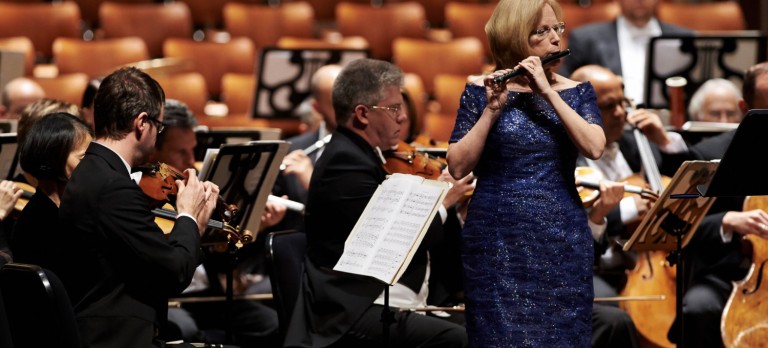“If A is a success in life, the A = x + y + z. Work is x, y is play and z is keeping your mouth shut.” - Albert Einstein
The Andover Educators conference at Iowa State was fantastic. I had 3 Alexander Technique lessons and a session with a physical therapist who is also a Feldenkrais practitioner. All 3 of these gentlemen zoomed right in on the unnecessary holding pattern and I now have lots of things to actually do to get rid of this. Part of it involves just saying “No” to the muscles that are trying to help. In my case, “No, dammit. Your help is not required here. Thanks for thinking of me. “ Thinking of the upper ribs pointing up at an angle towards the shoulder joint helps release the squished feeling in my upper arm. Having my first finger lead my whole arm into extension and noticing the texture of what I’m feeling helps get my finger/hand/arm integrated back into my whole. The physical therapist actually mentioned 3 exercises for strengthening that he said I would be doing, if I were his patient. I’m definitely going to check with my hand therapist. He also told me that there is a special interest group for Performing Arts within the APTA (American Physical Therapy Association). It’s a separate group from PAMA, although many of the practitioners are members of both.
I also performed in a masterclass for Amy Likar, Director of Training for Andover Educators, in my triumphant return to the stage! I thought long and hard about throwing my name in the lottery of people who wanted to play. What it came down to was that I’d like to see a master teacher work with an accomplished musician who is recovering from injury. So often, injured musicians don’t want to deal with this is public. In this case, I was absolutely confident that there wouldn’t be a more supportive audience for me anywhere on the planet. Quite honestly, I was ridiculously scared. I spent 15 minutes the day before just sitting on the stage with an empty house, wondering if I can do this or not. I could and I did. I asked my lovely friend Molly to accompany me on piano. Nice to have a friend right there... I told her she could start talking to me in a cartoon voice if it looked like I was freaking out. I’ve spent lots of time laughing at her trading cartoon voice messages with her own girls. We played the second movement of the Taktakishvili Sonata. This wasn’t the debut performance for my new flute that I envisioned back in August, but it was a success. I still have a key extension on the flute for the first finger, as well as the water tube stuck on there to increase the diameter of the tube. Again, a master teacher was able to guide me into ditching this stupid holding pattern and picking the flute up like I used to before being injured. Nice to notice that I can generate a huge sound on this flute without having to work as hard as I used to on the old flute, especially when I’m not doing unnecessary muscular work.
It was nice to appreciated by people at this conference. Moms generally don’t get warm fuzzies... or at least this mom doesn’t. That being said, there are always people who aren’t happy no matter what you do. The student workers at ISU were fabulous and definitely earned their money. Other fun conference things: my laptop died the night before my presentation (thankful for flash drive backup), my flight home was cancelled so I had to spend an extra night in Des Moines, and my reservation at the B&B was messed up so I was left scrambling for a place to stay the last night of the conference.
I struggled with the humidity there. Going from the super cold air conditioning to the hot, humid Iowa weather was painful. I could feel my hand expanding as I got out of the rental car to fill up the gas tank before returning it to the airport. Then getting back in, the air conditioning made my hand feel like it was shrink wrapped. The pressure changes on the airplane were not comfortable either. Plus I tried to do my exercises, but I didn’t do them as often as I should. Same for the icing - I made my own ice packs and had one set at the B&B and one set in the freezer at the music building.
Returning back to reality was hard. It seems that I’m on 100% - no more extra help for my hand. Fair enough, but it’s a shock to go from just taking care of yourself for a week to being responsible for two little people and a house. Plus I was exhausted and have a ton of paperwork stuff to sort out for the conference. Paying bills, writing checks, etc....
Got a phone call this week to interview for the adjunct flute position at a local university, so we’ll see what happens with that!
Key things I learned during this stage of my journey:
1) It felt fantastic to perform for an audience again. There was a time in this whole process where I felt that I may never be able to do that again. There’s immense satisfaction in knowing that I’ve done the work necessary to get to this stage.
2) It makes me feel better to be around other fantastic musicians who are such caring people. They understand the vulnerability that goes along with returning to playing after a devastating injury. Not to say that ordinary people don’t get it, but these folks GET it. These people are at the conference because they care about how bodies are put together and how they work. They also understand the terrible feeling of frustration and emptiness that goes along with not being able to make music. A soothing balm for my soul.
3) I feel so sorry for some colleagues who have other physical issues that can’t be fixed surgically. My injury is not fun, but it was something that can be fixed. So I was very fortunate, because there is no easy fix for some musicians. Sounds ridiculous to say that surgery is an easy fix because there has been nothing easy about this whole process for me.
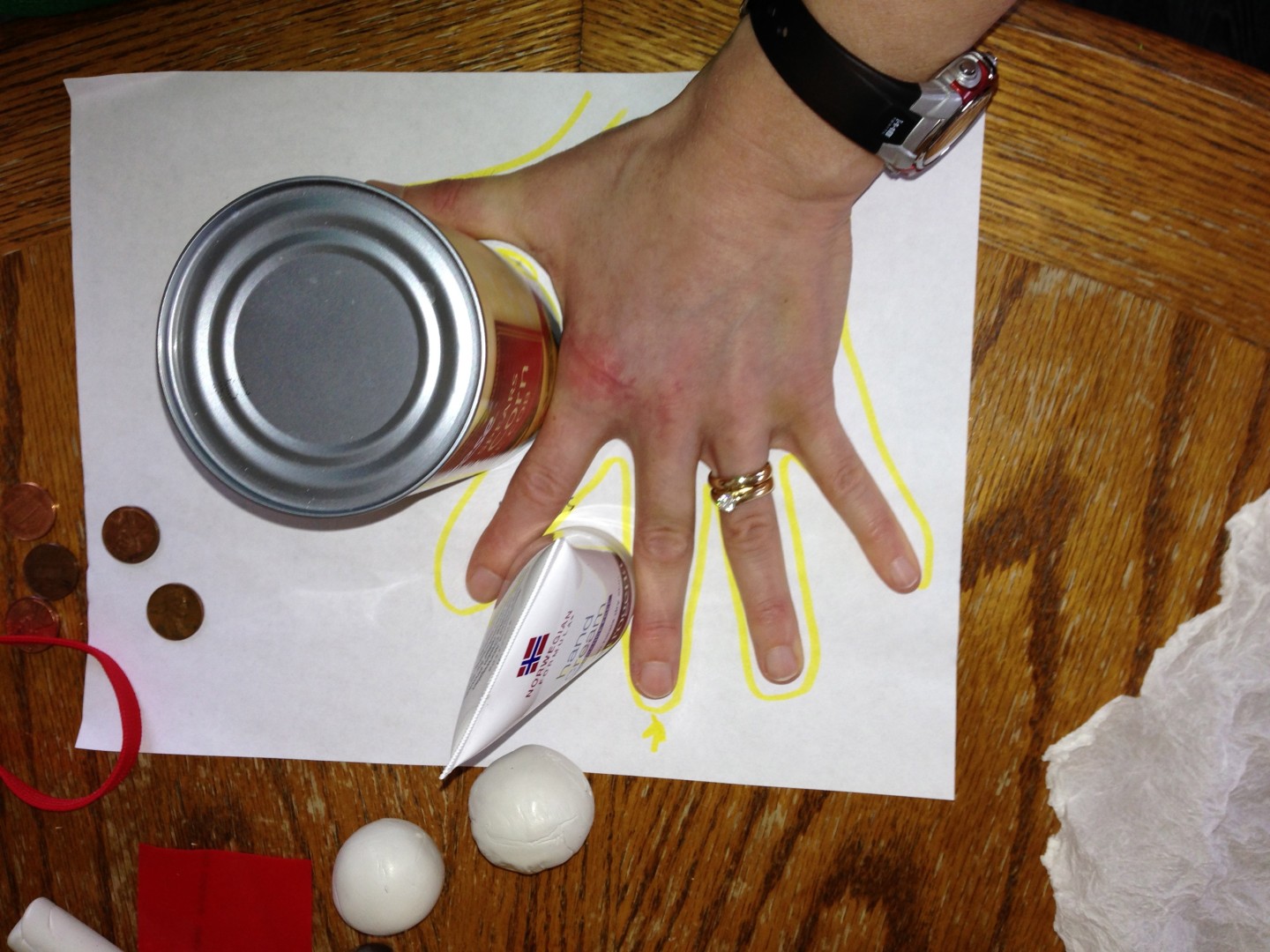
 I could hold silverware and fold laundry without thinking about it. I could dry my own hair using a hair dryer in one hand and a brush in the other. I could wash my kid’s hair and dry it. I could tie my shoes and wear my wedding band. I could drive without having to plan ahead about how I was going to steer, downshift, and turn the blinker on. I could use the drive-through window at the bank and reach out an get the little canister thing without having to practically climb out of the car. Woo hoo!
I could hold silverware and fold laundry without thinking about it. I could dry my own hair using a hair dryer in one hand and a brush in the other. I could wash my kid’s hair and dry it. I could tie my shoes and wear my wedding band. I could drive without having to plan ahead about how I was going to steer, downshift, and turn the blinker on. I could use the drive-through window at the bank and reach out an get the little canister thing without having to practically climb out of the car. Woo hoo! 1) Gentle assist on MP joint with same old tendon gliding exercises. My therapist explained that the only way to regain the length is to move to where it starts to pull, then gently assist with the other hand to move a little more, and then stay like that for 20-30 seconds. Hooray, finally something to “do” to actually help instead of sitting around passively waiting.
1) Gentle assist on MP joint with same old tendon gliding exercises. My therapist explained that the only way to regain the length is to move to where it starts to pull, then gently assist with the other hand to move a little more, and then stay like that for 20-30 seconds. Hooray, finally something to “do” to actually help instead of sitting around passively waiting. Why does this set of therapy tasks seem so much better to me? The answer is that it’s a game! I’m probably one of the most highly competitive individuals to walk the planet. I guess that comes from having an identical twin, so I can say that I’ve had years of experience and am a trained professional. I love any sport with a ball and a clearly defined goal. News flash --- this is probably helpful for the therapists to know.
Why does this set of therapy tasks seem so much better to me? The answer is that it’s a game! I’m probably one of the most highly competitive individuals to walk the planet. I guess that comes from having an identical twin, so I can say that I’ve had years of experience and am a trained professional. I love any sport with a ball and a clearly defined goal. News flash --- this is probably helpful for the therapists to know. The goal for now is 80 degrees, but I have 88 degrees in my right hand. The picture just shows movement of the other two joints without help from other fingers. She was pleased with my progress, but I still have to stay in the buddy wraps. Hopefully, next week I can be done with those and start the actual strengthening exercises. We’ll see. She said my adhesion wasn’t terrible and definitely wasn’t the worst she’s seen, but it remains something to get after often.
The goal for now is 80 degrees, but I have 88 degrees in my right hand. The picture just shows movement of the other two joints without help from other fingers. She was pleased with my progress, but I still have to stay in the buddy wraps. Hopefully, next week I can be done with those and start the actual strengthening exercises. We’ll see. She said my adhesion wasn’t terrible and definitely wasn’t the worst she’s seen, but it remains something to get after often.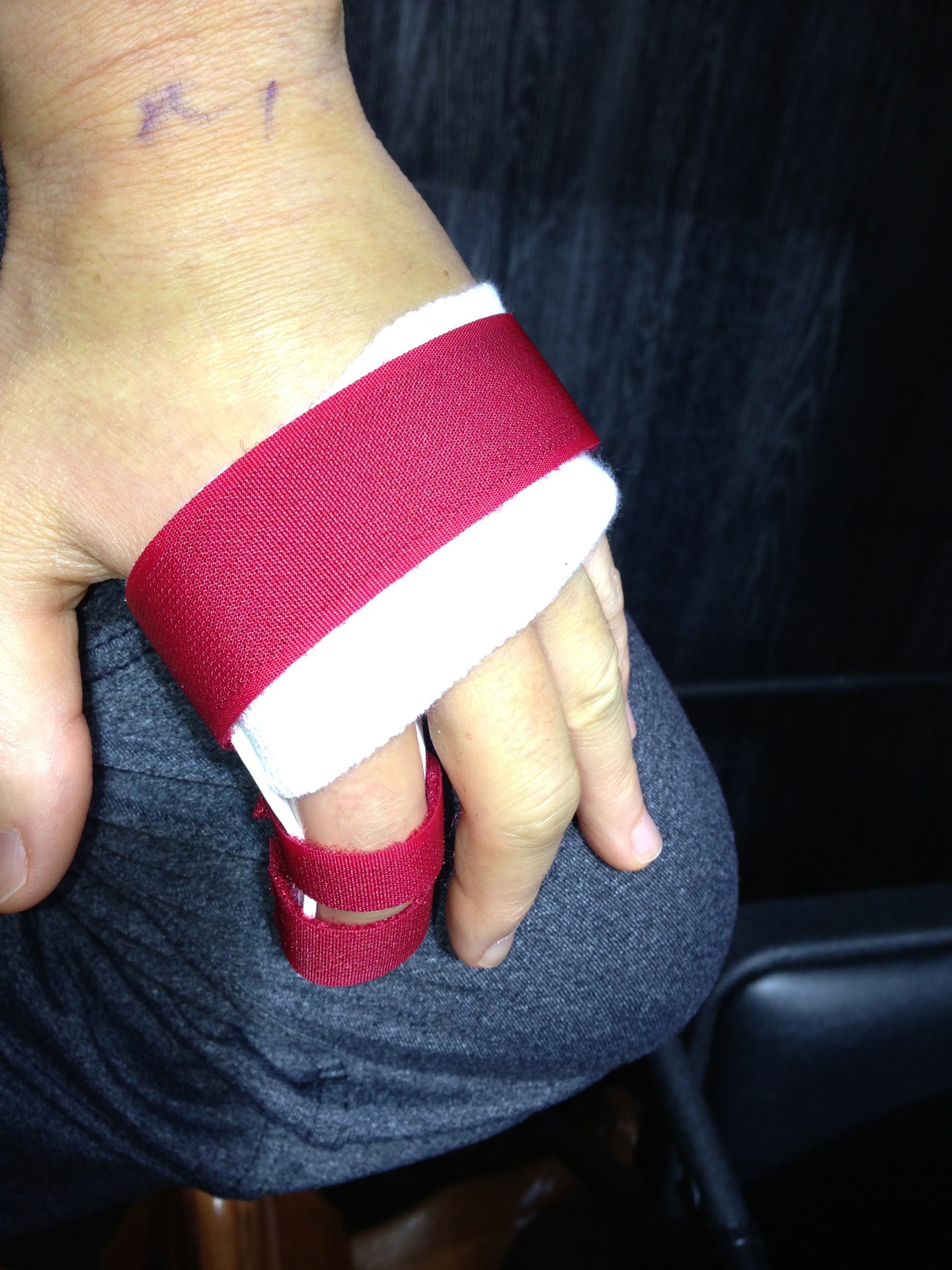
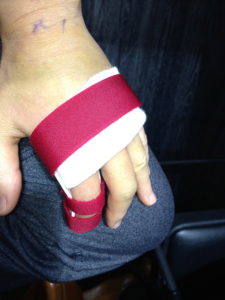 Then she gave me my exercises. My rehab consisted of 14 different exercises, all of which need to be repeated 10 times, with 4-5 sets of the whole thing per day. Wow... now the real work starts. The first exercise is forearm rotation. I teach this regularly as part of my Body Mapping course to musicians. This movement is an elbow movement and shouldn’t be a problem I thought. I quickly found out that I was wrong about this since all movements of my arm, wrist, hand, and fingers were compromised by the surgery and immobilization. Intellectually, I understood this. Practically, I was devastated that I had lost so much movement in such a short time. Before surgery, I had pretty much full use of my arm, wrist and hand. I learned to do things in weird ways to compensate for lack of pincer grasp. Complete and utter devastation. I felt like I was going to throw up while trying to do the exercises. Remember, how I said I stopped the Percocet? This was the wrong thing to do because the pain medication is absolutely necessary to get through the movements.
Then she gave me my exercises. My rehab consisted of 14 different exercises, all of which need to be repeated 10 times, with 4-5 sets of the whole thing per day. Wow... now the real work starts. The first exercise is forearm rotation. I teach this regularly as part of my Body Mapping course to musicians. This movement is an elbow movement and shouldn’t be a problem I thought. I quickly found out that I was wrong about this since all movements of my arm, wrist, hand, and fingers were compromised by the surgery and immobilization. Intellectually, I understood this. Practically, I was devastated that I had lost so much movement in such a short time. Before surgery, I had pretty much full use of my arm, wrist and hand. I learned to do things in weird ways to compensate for lack of pincer grasp. Complete and utter devastation. I felt like I was going to throw up while trying to do the exercises. Remember, how I said I stopped the Percocet? This was the wrong thing to do because the pain medication is absolutely necessary to get through the movements. My doctor gave me a prescription for Tylenol with codeine, as it was stronger than the plain Tylenol and not as strong as the Percocet. It literally felt like my hand was ripping apart inside. My therapist said there was nothing I could do to damage it as long as I moved my index finger only with it’s own muscles, with no moving it with my right hand. Many questions were asked so that I was crystal clear about how to find the line between appropriate effort and “too much.” My plan was and is to go right to the line every time.
My doctor gave me a prescription for Tylenol with codeine, as it was stronger than the plain Tylenol and not as strong as the Percocet. It literally felt like my hand was ripping apart inside. My therapist said there was nothing I could do to damage it as long as I moved my index finger only with it’s own muscles, with no moving it with my right hand. Many questions were asked so that I was crystal clear about how to find the line between appropriate effort and “too much.” My plan was and is to go right to the line every time.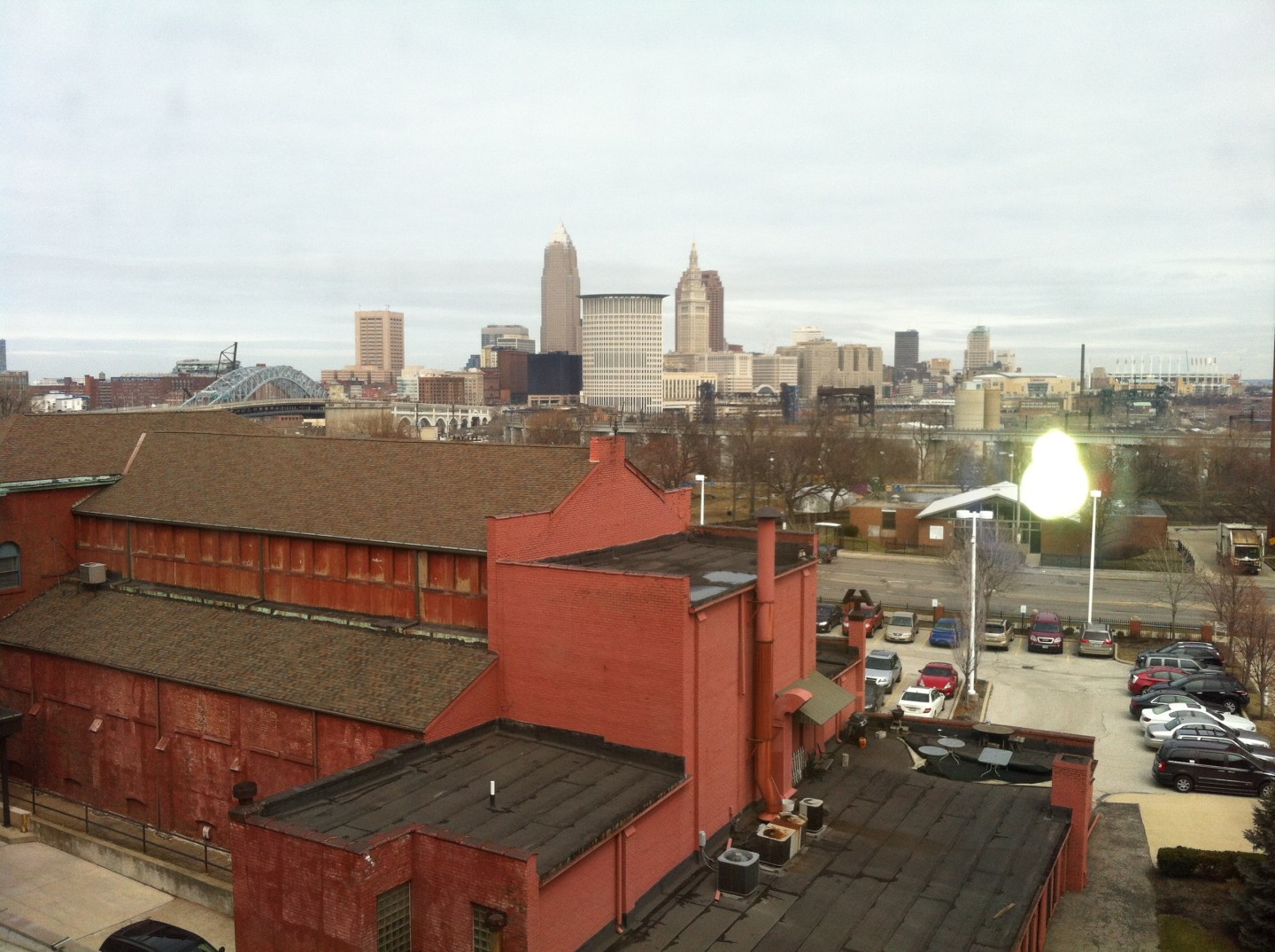
 The surgery itself was uneventful. My room at Lutheran Hospital had a great view of Cleveland landmarks: Lake Erie, Browns stadium, the Jake (now known as home of the Cleveland Indians Progressive Field, but I liked Jacobs Field better), the Carnegie bridge and the historic buildings of Ohio City. It was interesting that the restaurant where my husband and I had our first date and the Great Lakes Brewery, where we had our wedding rehearsal dinner, were just one block away. I told him that he could go have a beer while I was on the table. I was anxious about having a senior anesthesiologist, rather than some kid fresh out of medical school. I picked the best hand surgeon to be working on my hand, so why shouldn’t I have the best person putting my arm to sleep? I had a great anesthesiologist who did a fantastic nerve block. I had a regional nerve block, which involves lots of shots into your arm pit, and wasn’t really that bad since I already had some sedating meds going through the I.V. Off I went to the O.R. Next thing I know, I’m in recovery. The person on the other side of the curtain was whining her head off about pain. I supposed I should have been sympathetic, but I wasn’t. I only wanted her to stop. I was feeling no pain because of the fabulous nerve block. I remember thinking that my left arm was on my stomach, same as the right arm. When I finally was coherent enough to peek under the blankets, I only saw one arm. I asked my nurse, “Where’d my arm go?” She said, “It’s right here, honey, don’t worry” and pulled the blanket back so I could see it right there next to my body. I also asked her when the nerve block wears off and she replied, “Well, honestly it’ll go from feeling just fine to ‘holy shit”’in about 30 seconds.” I appreciated her honesty. I was taken back up to my room and discharged after an hour or so. I had a bulky dressing, which is a plaster cast on the outside of my arm and dressings on the inside, that went from elbow to fingertips. I had to wear a sling for the first day since the nerve block was still in effect and I had no idea what my arm was doing.
The surgery itself was uneventful. My room at Lutheran Hospital had a great view of Cleveland landmarks: Lake Erie, Browns stadium, the Jake (now known as home of the Cleveland Indians Progressive Field, but I liked Jacobs Field better), the Carnegie bridge and the historic buildings of Ohio City. It was interesting that the restaurant where my husband and I had our first date and the Great Lakes Brewery, where we had our wedding rehearsal dinner, were just one block away. I told him that he could go have a beer while I was on the table. I was anxious about having a senior anesthesiologist, rather than some kid fresh out of medical school. I picked the best hand surgeon to be working on my hand, so why shouldn’t I have the best person putting my arm to sleep? I had a great anesthesiologist who did a fantastic nerve block. I had a regional nerve block, which involves lots of shots into your arm pit, and wasn’t really that bad since I already had some sedating meds going through the I.V. Off I went to the O.R. Next thing I know, I’m in recovery. The person on the other side of the curtain was whining her head off about pain. I supposed I should have been sympathetic, but I wasn’t. I only wanted her to stop. I was feeling no pain because of the fabulous nerve block. I remember thinking that my left arm was on my stomach, same as the right arm. When I finally was coherent enough to peek under the blankets, I only saw one arm. I asked my nurse, “Where’d my arm go?” She said, “It’s right here, honey, don’t worry” and pulled the blanket back so I could see it right there next to my body. I also asked her when the nerve block wears off and she replied, “Well, honestly it’ll go from feeling just fine to ‘holy shit”’in about 30 seconds.” I appreciated her honesty. I was taken back up to my room and discharged after an hour or so. I had a bulky dressing, which is a plaster cast on the outside of my arm and dressings on the inside, that went from elbow to fingertips. I had to wear a sling for the first day since the nerve block was still in effect and I had no idea what my arm was doing.